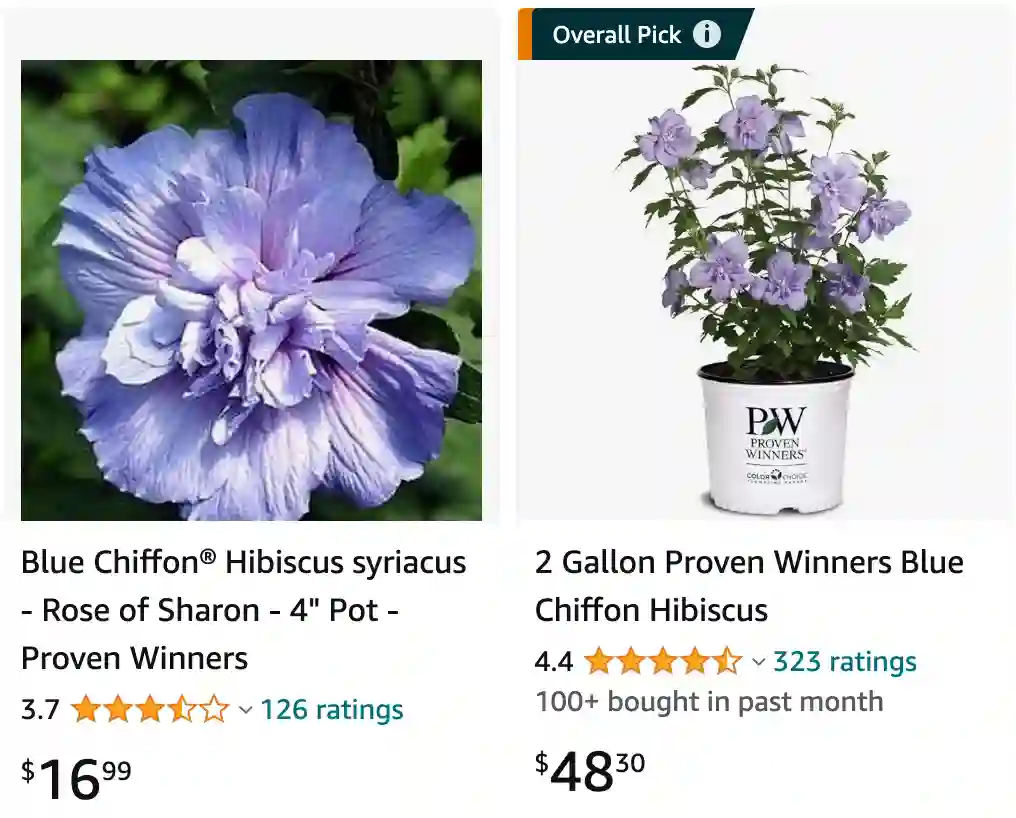
All About the Hibiscus Blue Chiffon: Your Questions Answered
Hi there, Ferb Vu here, and I’m ready to dive into the world of Hibiscus Blue Chiffon, a stunning flowering shrub that’s sure to add a touch of elegance to your garden.
This beauty has captured the hearts of many gardeners with its captivating lavender-blue blooms and easy-going nature. But with any plant, questions arise. So, I’ve compiled a comprehensive FAQ to address everything you might want to know about the Hibiscus Blue Chiffon.
439 Species in Genus Hibiscus
What Makes the Hibiscus Blue Chiffon Special?
The Hibiscus Blue Chiffon, also known as the Blue Chiffon Rose of Sharon, is a deciduous shrub prized for its large, showy flowers. These blooms boast a delightful lavender-blue hue with a touch of lace at their center, resembling an anemone flower. They bloom profusely throughout late summer and into autumn, bringing a burst of color to your landscape when many other plants are starting to fade.
Beyond its mesmerizing flowers, the Hibiscus Blue Chiffon is a low-maintenance shrub. It’s tolerant of heat, drought, and even salt, making it a perfect choice for hot and dry climates. Plus, it’s relatively pest and disease resistant, sparing you the worry of constant care.
How Do I Care for My Hibiscus Blue Chiffon?
Taking care of your Hibiscus Blue Chiffon is a breeze. Here’s what you need to know to keep it thriving:
- Sunshine: This sun-loving shrub prefers full sun to partial shade. Aim for at least 6 hours of direct sunlight daily to promote abundant flowering.
- Watering: While drought tolerant, consistent moisture is ideal for optimal growth and flowering. Water your Hibiscus Blue Chiffon regularly, especially during dry spells, allowing the soil to dry slightly between waterings.
- Soil: Well-drained soil is key. The Hibiscus Blue Chiffon isn’t fussy about soil type or pH, but it won’t tolerate soggy conditions. If your soil is heavy clay, consider amending it with sand or compost to improve drainage.
- Feeding: While not essential, a balanced fertilizer applied in early spring can promote healthy growth and even more blooms.
- Pruning: Regular pruning isn’t necessary, but you can prune your Hibiscus Blue Chiffon in late winter or early spring to remove dead or weak branches, control its size, and shape it as desired.
How Big Does the Hibiscus Blue Chiffon Get?
The Hibiscus Blue Chiffon can mature to a height and spread of 8 to 12 feet. This makes it a great choice for adding a flowering backdrop to your borders or creating a stunning focal point in your garden.
Is the Hibiscus Blue Chiffon a Fast Grower?
The Hibiscus Blue Chiffon has a moderate growth rate, typically maturing within a few years. This means you won’t have to wait too long to enjoy its beautiful blooms.
Can I Grow the Hibiscus Blue Chiffon in a Pot?
Yes, you absolutely can grow the Hibiscus Blue Chiffon in a pot. Choose a large pot with good drainage holes to accommodate its mature size. Repot every few years as it grows, ensuring the pot provides enough space for its roots. Remember, container plants dry out faster than those in the ground, so be mindful of watering needs, especially during hot weather.
What Diseases or Pests Does the Hibiscus Blue Chiffon Attract?
The good news is that the Hibiscus Blue Chiffon is generally resistant to most pests and diseases. However, aphids, mealybugs, and lace bugs can occasionally be an issue. If you notice any pests, address them promptly with insecticidal soap or neem oil spray.
How Does the Hibiscus Blue Chiffon Compare to Other Hibiscus Varieties?
There are many Hibiscus varieties out there, each with its unique charm. Here’s a quick comparison of the Hibiscus Blue Chiffon to two popular choices:
- Rose of Sharon (Hibiscus syriacus): The Blue Chiffon is a type of Rose of Sharon, but there are many other varieties available. They come in a wider range of flower colors, from white and pink to purple and red. Generally, other Rose of Sharon varieties share similar care requirements as the Blue Chiffon.
- Tropical Hibiscus (Hibiscus rosa-sinensis): Unlike the Blue Chiffon, Tropical Hibiscus are evergreen shrubs that thrive in warm, humid climates. They boast large, vibrantly colored flowers year-round but aren’t as cold hardy as the Blue Chiffon.
With its captivating blooms, easy care requirements, and tolerance for various conditions, the Hibiscus Blue Chiffon is a remarkable shrub that deserves a spot in your garden. So, if you’re looking for a low-maintenance beauty to add a touch of sophistication and late-summer color, look no further than the Hibiscus Blue Chiffon.
Here are some additional points to consider:
- Deer Resistance: Another bonus – the Hibiscus Blue Chiffon is generally deer resistant. This can be a significant advantage if deer are a common problem in your area.
- Companion Plants: For a stunning display, consider pairing your Hibiscus Blue Chiffon with other late-blooming perennials like butterfly bushes (Buddleia davidii), Russian sage (Perovskia atriplicifolia), or ornamental grasses.
- Winter Dormancy: As a deciduous shrub, the Hibiscus Blue Chiffon loses its leaves in fall and enters a dormant state. Don’t be alarmed by this natural cycle. With proper care, it will return to life with vibrant blooms come late summer.
By following these simple tips, you can ensure your Hibiscus Blue Chiffon thrives in your garden for years to come, rewarding you with its captivating beauty season after season.
If i die, water my plants!


